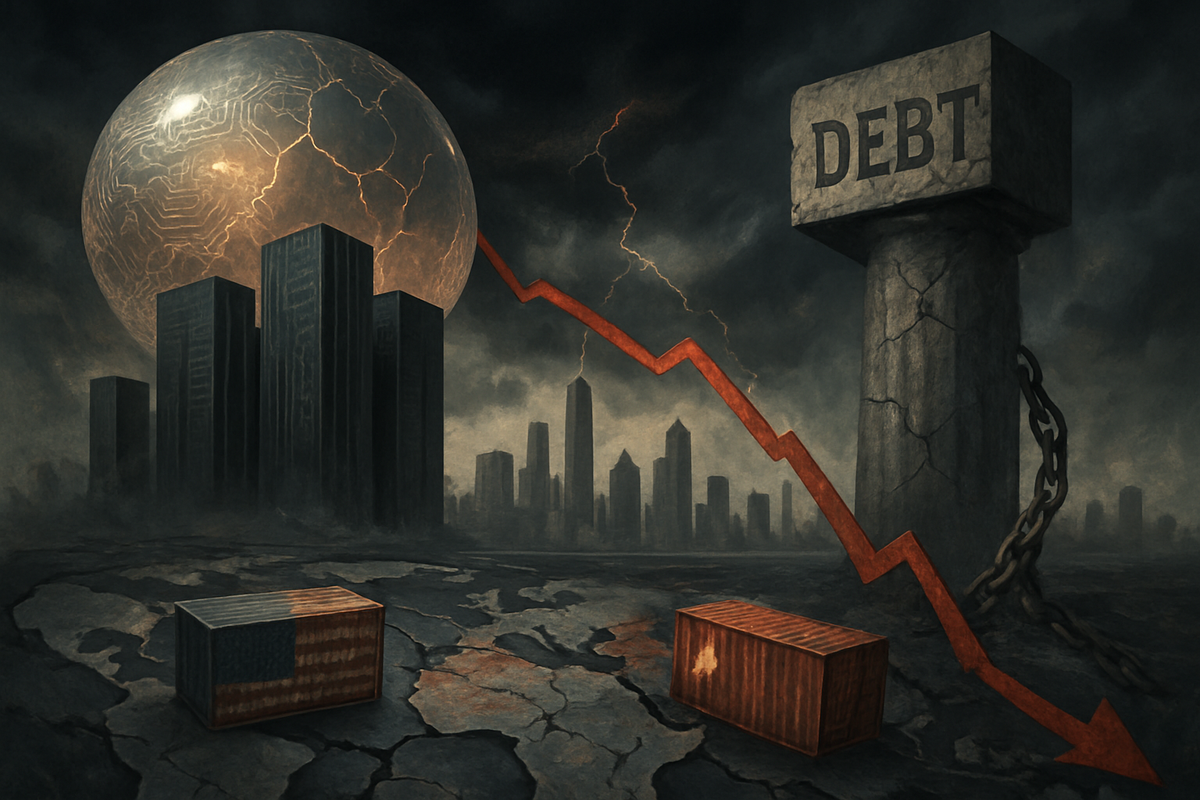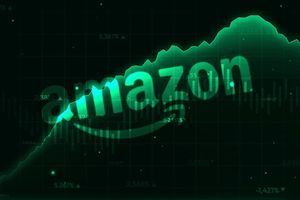
As of October 14, 2025, a palpable sense of unease permeates global financial markets, with a growing chorus of analysts and institutions warning of a potential market crash. The prevailing sentiment is a complex mix of resilience in equity markets, particularly in the booming artificial intelligence (AI) sector, juxtaposed with an escalating undercurrent of caution. The primary catalysts for these deepening anxieties are identified as potential overbuilding in the AI industry, intensifying global trade wars, and persistently ballooning national debts across major economies.
This convergence of factors is creating a precarious environment, where record-high equity valuations, especially in tech, appear increasingly disconnected from underlying economic fundamentals. Investors are grappling with the implications of a potentially overvalued AI market, the disruptive force of renewed protectionist trade policies, and the long-term fiscal instability posed by unprecedented levels of sovereign debt. The immediate implications are already being felt, with recent market volatility signaling a "risk-off" posture as market participants brace for significant economic headwinds.
A Precarious Confluence: AI Bubble, Trade Wars, and Debt Burdens
The specter of a financial market crash is increasingly linked to a trifecta of interconnected threats, each capable of independently triggering a downturn but far more potent in their combined effect. The AI sector, once hailed as the engine of future growth, is now eyed with suspicion by many who see parallels to past speculative bubbles. Meanwhile, a renewed and aggressive stance in global trade, particularly between economic superpowers, threatens to unravel decades of economic integration. Underlying these immediate concerns is the persistent, long-term challenge of national debts reaching unsustainable levels, straining fiscal capacities and raising questions about future economic stability.
The AI Bubble: A Modern-Day Dot-Com?
Concerns about an AI bubble have reached a fever pitch by October 2025, with institutions like the Bank of England warning of a "sharp market correction" due to stretched equity valuations in AI-focused technology companies. Both the International Monetary Fund (IMF) and Oxford Economics have echoed these fears, predicting a potential "sharp correction in tech stocks, with negative knock-ons for the real economy." Analysts are drawing comparisons to the dot-com bubble of the late 1990s, with some suggesting the current AI bubble is considerably larger. Warnings point to inflated valuations of AI startups, often lacking substantial earnings, and a "circular business relationship" where major AI players like NVIDIA (NASDAQ: NVDA) and Advanced Micro Devices (NASDAQ: AMD) invest in language model startups that then use the capital to purchase their chips. Economist Jason Furman estimated that AI spending accounted for a staggering 92% of U.S. GDP growth in the first half of 2025, raising serious questions about the sustainability of this growth trajectory. Even figures like Amazon (NASDAQ: AMZN) founder Jeff Bezos and OpenAI CEO Sam Altman have acknowledged the possibility of an "industrial bubble" in AI, albeit with varying degrees of optimism regarding its long-term impact. Reports also indicate that companies are taking on significant debt to fund AI development, a factor that could amplify the severity of a market downturn.
Escalating Trade Wars: A Return to Protectionism
The global economic landscape is being profoundly reshaped by escalating trade tensions, particularly between the United States and China. As of mid-October 2025, the dispute has intensified into an "economic confrontation," characterized by reciprocal tariffs, expanded export controls, and targeted sanctions. President Donald Trump's threat on October 10 to impose an additional 100% tariff on all Chinese imports, effective November 1, has been met with vows of retaliation from Beijing. China, in turn, has implemented new export restrictions on rare earths, adding another layer of complexity and risk to global supply chains. These escalating tensions are widely identified as a primary "downside risk" to global growth, with the Organisation for Economic Co-operation and Development (OECD) warning in March 2025 that higher and broader trade barriers would "hit growth around the world and add to inflation." The World Trade Organization (WTO) Director-General, Ngozi Okonjo-Iweala, has voiced deep concern over a "profoundly worrying" split in global trade systems. The immediate impact was evident on October 14, 2025, when renewed trade tensions triggered a sharp decline in U.S. stock markets, with technology and AI-focused stocks experiencing the most significant losses, reflecting a clear "risk-off" stance among investors.
National Debt: A Looming Fiscal Crisis
The issue of large national debts continues to be a pervasive global concern, with public debt levels rising at an alarming rate. Governments worldwide significantly increased spending during the pandemic, and these elevated levels have largely persisted, leading to growing fiscal deficits. The U.S. federal government's debt, for instance, reached an staggering $37 trillion by August 2025, with a substantial portion of tax revenues now allocated to servicing interest payments. The Congressional Budget Office (CBO) projects U.S. federal debt held by the public to increase from 99% of GDP in 2024 to 116% by 2034 and a staggering 172% by 2054. This growing debt burden severely limits governments' "fiscal capacity," reducing their ability to respond effectively to future economic crises and to invest in critical public services. Rising interest rates exacerbate the cost of debt servicing, further straining national budgets. The IMF highlights that markets might be "underestimating the potential effects of tariffs on growth and inflation" and the risks associated with mounting debt. There is a tangible risk of fiscal crises, particularly in less wealthy nations, and a broader concern that a debt-related crisis in a central player like the U.S. could trigger a global economic contraction.
Winners and Losers in a Volatile Landscape
A potential market crash, triggered by AI overbuilding, trade wars, and national debt, would undoubtedly create a distinct divide between winning and losing companies. The impact would ripple across sectors, favoring those with strong balance sheets, diversified operations, and essential services, while punishing those with overstretched valuations, heavy reliance on global supply chains, and significant debt exposure.
Companies heavily invested in the AI sector, particularly those with speculative valuations and limited profitability, stand to lose the most. Many AI startups and even some established tech giants like Microsoft (NASDAQ: MSFT), Alphabet (NASDAQ: GOOGL), and Meta Platforms (NASDAQ: META), which have seen significant valuation boosts due to AI hype, could face substantial corrections if the bubble bursts. Semiconductor companies like NVIDIA (NASDAQ: NVDA) and Advanced Micro Devices (NASDAQ: AMD), while fundamental to AI, could also see demand cool if AI investment slows dramatically. Companies with extensive manufacturing operations in China or heavy reliance on global supply chains, such as Apple (NASDAQ: AAPL) and various automotive manufacturers, would be severely impacted by escalating trade wars and tariffs. Their profit margins would shrink due to increased input costs, and their ability to sell in key markets would be hampered. Furthermore, companies with high levels of corporate debt would struggle in an environment of rising interest rates, exacerbated by growing national debts that push bond yields higher.
Conversely, certain sectors and companies might prove more resilient or even thrive. Defensive stocks in consumer staples (e.g., Procter & Gamble (NYSE: PG), Coca-Cola (NYSE: KO)), utilities, and healthcare (e.g., Johnson & Johnson (NYSE: JNJ)) tend to perform better during economic downturns as demand for their products remains relatively stable. Gold mining companies and other commodity producers could benefit from a flight to safety, as seen with gold prices surging to record highs on October 14, 2025. Companies with strong balance sheets, significant cash reserves, and low debt would be better positioned to weather the storm, potentially acquiring distressed assets at attractive valuations. Furthermore, companies offering critical, non-discretionary software or services that are essential regardless of economic conditions might see sustained demand. Cybersecurity firms, for instance, could maintain their importance as digital threats persist. Businesses with diversified revenue streams and less reliance on single markets or supply chains would also demonstrate greater resilience.
Broader Significance and Historical Echoes
The current confluence of AI overbuilding, trade wars, and national debt carries significant broader implications, threatening to reshape global economic structures, challenge existing regulatory frameworks, and potentially usher in a new era of economic nationalism. This isn't merely a cyclical downturn; it represents a potential paradigm shift with far-reaching consequences.
The AI phenomenon, while transformative, fits into a broader trend of technological disruption often accompanied by speculative bubbles. Historically, periods of rapid technological advancement, such as the railway boom of the 19th century or the dot-com era, have seen irrational exuberance leading to market corrections. The current AI enthusiasm, driven by promises of unprecedented productivity gains, mirrors these past events. Should the AI bubble burst, it would not only impact the tech sector but also ripple through the venture capital landscape, employment markets (especially for highly skilled AI professionals), and the broader economy, as the promised productivity gains fail to materialize in the short term. This could lead to a significant re-evaluation of investment strategies and a more cautious approach to emerging technologies.
Escalating trade wars represent a stark departure from the globalized, free-trade principles that have largely governed international commerce for decades. This shift towards protectionism threatens to fragment global supply chains, increase production costs, and reduce overall economic efficiency. The "decoupling" efforts, particularly between the U.S. and China, could lead to a bifurcation of technological standards and economic blocs, complicating international business operations and potentially stifling innovation. Regulatory bodies would face immense pressure to adapt to these new trade realities, potentially enacting new tariffs, subsidies, and industrial policies aimed at protecting domestic industries. Historically, trade wars have often preceded or exacerbated economic downturns, as seen in the 1930s. The current situation could trigger a period of "stagflation"—high inflation coupled with stagnant economic growth—as tariffs push up prices and trade barriers reduce output.
The unprecedented levels of national debt across major economies, particularly the U.S., pose a fundamental challenge to fiscal sustainability. This situation limits governments' ability to respond to future crises, whether economic, environmental, or geopolitical. The increasing allocation of tax revenues to debt servicing crowds out essential public investments in infrastructure, education, and research, hindering long-term growth potential. Regulatory and policy implications are significant, as governments may be forced to consider austerity measures, tax increases, or even debt restructuring, all of which carry political and social risks. The historical precedent for sovereign debt crises is severe, often leading to currency devaluations, hyperinflation, or prolonged economic stagnation. The current scenario is particularly concerning because it affects major global reserve currency issuers, raising the stakes for the entire international financial system.
The Road Ahead: Navigating Uncertainty
The path forward for financial markets is fraught with uncertainty, demanding strategic pivots and adaptive measures from investors, businesses, and policymakers alike. The short-term outlook suggests continued volatility, while the long-term trajectory will depend heavily on the actions taken to address the intertwined challenges of AI overbuilding, trade wars, and national debt.
In the short term, market participants should anticipate heightened fluctuations, driven by news regarding trade negotiations, central bank policies (such as the Federal Reserve's anticipated rate cuts despite persistent inflation), and corporate earnings reports, particularly from the tech sector. A "risk-off" environment is likely to persist, favoring defensive assets and companies with robust cash flows and low leverage. Investors may rotate out of highly speculative AI stocks into more value-oriented or dividend-paying equities. Companies will need to reassess their supply chain vulnerabilities, potentially diversifying manufacturing bases away from politically sensitive regions to mitigate trade war impacts. Governments, meanwhile, will face immediate pressure to manage inflation while avoiding a deep recession, a delicate balancing act given the constraints of national debt.
Looking further ahead, several scenarios could unfold. A "soft landing" is possible if AI innovation translates into genuine productivity gains, trade tensions de-escalate through diplomatic efforts, and governments implement credible fiscal reforms to address debt. In this optimistic scenario, market corrections would be temporary, paving the way for renewed, sustainable growth. However, a more pessimistic scenario involves a "hard landing"—a full-blown market crash and recession. This could be triggered by a sharp burst of the AI bubble, a full-scale trade war leading to significant global supply chain disruptions, or a sovereign debt crisis in a major economy. Such a scenario would necessitate aggressive fiscal and monetary interventions, potentially leading to prolonged economic stagnation. Strategic pivots for businesses will include increasing automation to reduce labor costs, reshoring production where feasible, and investing in R&D that delivers tangible, profitable applications rather than just hype. New market opportunities could emerge in sectors resilient to economic downturns, such as infrastructure development, renewable energy (driven by long-term policy goals), and localized production chains.
A Crucial Juncture for Global Finance
The current predictions of a financial market crash, fueled by AI overbuilding, escalating trade wars, and burgeoning national debts, mark a crucial juncture for global finance. The key takeaway is the interconnectedness of these challenges: a burst AI bubble could exacerbate trade tensions as nations compete for technological dominance, while mounting national debts limit governments' ability to cushion economic shocks from either. The market moving forward will likely be characterized by increased discernment, where fundamental analysis and prudent risk management will regain prominence over speculative fervor.
The market's recent reaction, with U.S. stocks declining sharply on October 14, 2025, and gold prices surging, underscores the fragility of investor confidence. While the Federal Reserve has begun cutting rates, signaling an attempt to support the economy, the persistence of inflation above target adds another layer of complexity. Investors should watch closely for signs of de-escalation in trade disputes, evidence of sustainable profitability in the AI sector, and concrete steps from governments to address fiscal imbalances. Corporate earnings reports, particularly from technology companies, will provide critical insights into the real-world impact of AI investment. Furthermore, central bank communications regarding interest rate policy and inflation targets will be paramount. The coming months will be a test of resilience for global financial systems, demanding careful navigation from all stakeholders to avoid a significant economic contraction and to chart a course towards more sustainable growth.
This content is intended for informational purposes only and is not financial advice






